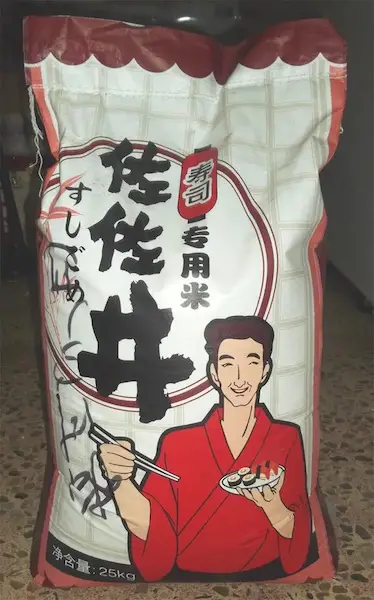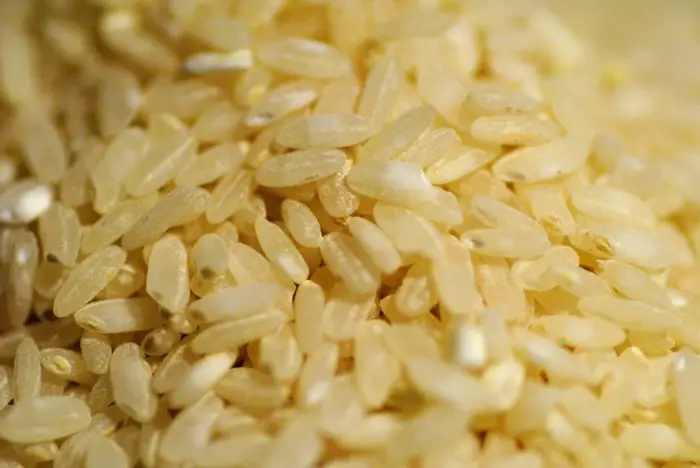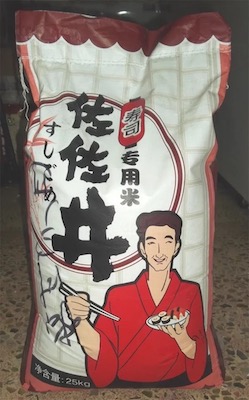We are reader supported. When you purchase through links on our site, we may earn an affiliate commission. Also, as an Amazon affiliate, we earn from qualifying purchases.

If you visit an Asian grocery store, you can see shelves with rice packets labeled as ‘sushi rice’. In reality, there is nothing called ‘sushi rice’ in Japan and they use that term only to refer to rice after it has been cooked and seasoned to use for sushi. In western countries, rice varieties that are suitable for making sushi are often labeled as sushi rice to make it easier for beginners to understand.
My friend once bought a large packet of sushi rice and she asked me ‘does uncooked sushi rice go bad?’ I told her to relax because white short-grain Japanese rice, when kept in a sealed bag in normal pantry conditions can last almost indefinitely. Once the seal is opened, it can also be stored inside the freezer or refrigerator for as long as you like.
The biggest challenge in keeping the uncooked sushi rice form going bad is to protect it from dust, moisture, insects, and other contaminants. However, please note that the indefinite shelf life works only for the different varieties of white rice that have been milled and stripped of its outer layer. The low moisture content of white rice is responsible for giving it an extended life.
If you choose to use other varieties of rice such as brown rice for making sushi, it’s a different story altogether. Brown rice has a higher oil content which makes it stay good in the pantry under room temperature only for 3-6 months. When stored in vacuum sealed bags in the refrigerator, it can last for 6-12 months and in the freezer, it can stay good up to 6-18 months.
Contents
Reason Behind The Long Shelf Life Of White Rice
Rice typically consists of four different parts – the hull, bran, white rice, and germ. The hull or husk is the toughest outer part of the grain. It is removed in all types of rice before making them ready for consumption.
Bran is the layer under hull and this part is not removed in all varieties. The whole grains, such as brown rice retain the bran layer which is usually tan-colored but may be black or reddish depending on the pigmentation. In brown rice, the bran layer is eaten but in some varieties (white rice), it is removed by further processing.
Germ, also known as rice kernel, is the nutrient-dense part found under the hull. It is responsible for giving nutritional benefits and color to rice. When the hull, bran, and germ layers are removed, the white rice remains. It is the endosperm and the most commonly consumed part in all varieties of rice.
As the traditional sushi rice comprises of white rice that has been processed to get rid of the upper layers that are more susceptible to spoilage, it tends to have a higher shelf life compared to whole grains like brown rice that retains the bran part.
Different Types Of Uncooked Rice Used In Sushi
If you are in the market looking for rice, you will come across three main varieties – short, medium, and long grains. They are named so based on the length and shape of the grain. Let’s take a look at them and find out which variety works best for sushi and why:
Long-Grain Rice
The long-grain rice are milled grains and they are 3-4 times as long as their width. The unique starch composition makes them light and fluffy when cooked. Long-grain rice should never be used for making sushi because it lack the stickiness or starchiness required to put rice together in shape. The cooked rice will separate and fall apart creating a mess.
Medium Grain Rice
The medium-grain variety is comparatively shorter than long-grain and has a wider kernel. When cooked, the grains are more tender and moist, with a tendency to stick together. In the absence of short-grain rice, medium-grain rice varieties such as Calrose may be used for making sushi. The dish will not be truly authentic, but it will still be eatable.
Short Grain Rice

The short-grain Japanese rice is ideal type used for making sushi, mainly due to its unique sticky texture. They are characterized by their short length and plump shape. The grains contain more moisture content than other varieties, hence they are sticker when cooked.
When you find packages labeled as ‘sushi rice’ in the grocery stores or supermarkets, they are essentially short grain rice. Koshihikari is the best variety of short-grain rice available. There are a few things you may need to consider when buying sushi rice – texture, flavor, freshness, and stickiness.
To get the best results, ask for the shinmai variety of short-grain rice. Shinmai is a Japanese term which means new rice. It refers to the first crop that was harvested in the season and processed for sale. Shinmai gives you the perfect texture needed for making sushi.
Some of the commonly available brands for sushi rice are Toyama Koshihikari, Shirakiku Rice, and Komachi (California short-grain rice). If you have to use medium grains for making sushi, go for the Nishiki and Kokuho Rose brands. Another acceptable substitute for Japanese short-grain rice is the Italian short grain rice.
Brown Rice

As mentioned above, brown rice is the variety with its bran intact, hence it is considered as whole grains that are high in nutritional value. Although brown rice is not used in sushi in Japan, there are many US restaurants that use brown rice for sushi to attract the health conscious westerners.
No wonder brown rice is highly praised for its nutritional value, but it cannot create the same taste as traditional short-grain sushi rice. According to Michelin-starred chefs, brown rice contains higher amounts of fiber and other elements that give it an earthy flavor and chewy texture.
When used in sushi, the strong taste of brown rice overpowers the delicate flavors of sushi-grade tuna and salmon fish. Unlike the short-grain white rice, the cooked brown rice stays firm even after it’s cooked so there’s a lot of chewing needed to eat the rice part of sushi and this is not desirable.
Sushi Rice Is Not The Same As Sticky Rice
Sushi rice is known for its stickiness but it should not be confused with sticky rice or glutinous rice, known as mochigome in Japanese. It is another type of japonica rice cultivar that has a very sticky texture and is used for preparing a variety of traditional dishes such as mocha, rice crackers, and sweets.
The sticky rice should not be used for making sushi because it is too sticky and clumpy to use. I have created an article that explains the difference between sushi rice and sticky rice – Is sushi rice sticky rice?
Tips To Store Uncooked Sushi Rice Correctly
To prevent the rice from going bad, always store it in a cool and dry area. After the package is opened, transfer the contents into an airtight container and keep away from moisture.
While white rice can be kept in normal pantry conditions, they may be at risk of dust, bugs or insects that can cause damage. To keep uncooked rice in best condition, store the re-sealed bag inside the refrigerator or freezer.
If you bought a sushi rice packet from the supermarket or grocery store, it will have an expiry date printed in the packet. When you store the uncooked rice in an airtight container, write the expiry date on the top with a pen or marker.
Signs That Tell Uncooked Rice Has Gone Bad
If you love sushi so much that you find yourself making it for dinner almost every week, the uncooked rice will probably disappear fast. Those who bought rice for a party or special occasion can also store it until further use. However, once you have opened the seal, the rice is susceptible to damage.
Even if you keep it inside the fridge or freezer, power failure for a long time may result in spoilage. If you practice food safety techniques, it can keep your family away from food borne illnesses. Here are a few signs that indicate uncooked sushi rice has gone bad.
As uncooked rice has an extended shelf life, it’s hard to tell if it’s rotten or spoiled. One of the deadliest enemies of white rice is weevil, a small reddish-brown colored bug that can be seen within the rice. If you find them, discard the rice and disinfect the container as well as the place where the container was placed.
If the texture of the uncooked rice seems to have changed and it’s not perfectly dry, this indicates that moisture has found its way into the container. You must discard the rice immediately.
If the refrigerated or frozen sushi rice emits an unpleasant or off odor when you open the packet, this means that the rice has gone bad. You must toss it away. There are certain health risks associated with spoiled food, so use it before the shelf life expires.
Brown rice spoils fast and the signs are more visible. The outer coating of the grains become oily and they emit a rancid smell due to the essential fatty acids that undergo oxidation.
If your sushi rice has gone bad and you need an immediate substitution, read my article that talks about the best replacements you can use for sushi rice.
Related Questions
How to make perfect sushi rice?
Short-grain takes about 30 minutes to cook in a cooker or pot. I have created an article that includes step-by-step instructions on how to cook and season sushi rice.
What are the other uses of uncooked sushi rice?
Apart from making sushi, short-grain rice can also be used for making plain rice, pudding, molded salads, and rice dumplings. It can often be used as a substitute for sticky rice.
How long does cooked sushi rice last?
Cooked sushi rice can last for about 3-5 days, if stored in an airtight container inside the refrigerator. It is best to consume it within 2 days. If you see change in texture (it usually hardens) or signs of mold, discard the rice immediately.

